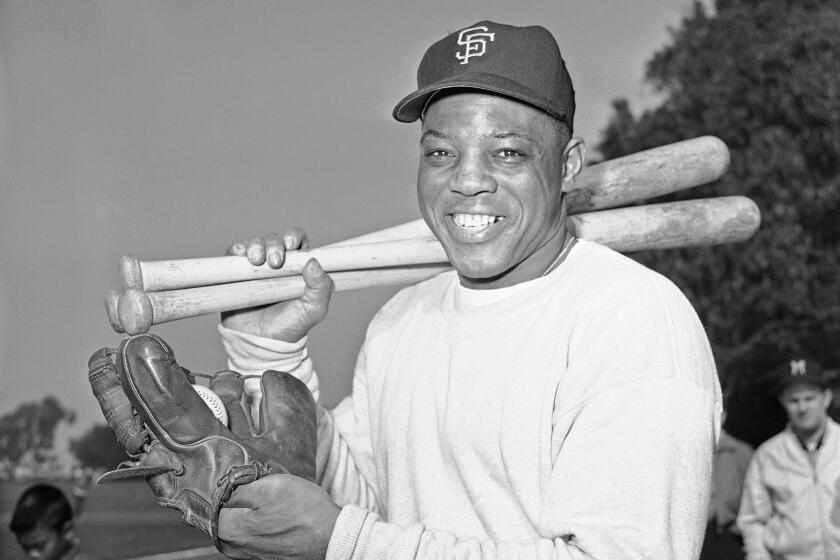Note to Drivers: Slow Down -- Enjoy the Arroyo
It’s part historic route, touted as the “first freeway of the west” when it opened as a parkway in 1940. Part integrated channel, its swooping curves designed to mimic the Arroyo Seco it parallels. Part speedway, hurtling almost 100,00 commuters a day between work and home.
The Pasadena Freeway -- that 8.2-mile stretch of twisty, turny road connecting Pasadena to Los Angeles -- has been the source of inspiration and consternation to motorists who must navigate it daily.
Once a drive along it was a leisurely affair. When it was built, the Arroyo Seco Parkway, as it was then called, carried 27,000 automobiles a day, most at speeds of less than 45 mph. Groundbreaking for their time, safety features such as red reflectors, directional signs and lanes differentiated by varying shades of concrete ensured that the parkway had a remarkably low accident rate compared with the rates on other highways of similar traffic volume.
But much has changed in 60 years. A new report published in Access, a journal of the University of California’s Transportation Center, says the Pasadena Freeway has become “the unsafest route in the region.”
Once designed to be a model of aesthetic delight and transportation efficiency, in which the trip was as meaningful as the destination, the parkway has become a commuter’s refuge, write the study’s authors, providing a direct, yet sometimes arduous, conduit between Los Angeles and its closest suburbs.
With the help of several students, authors Anastasia Loukaitou-Sideris, chairwoman of the urban planning department at UCLA, and Robert Gottlieb, a professor at Occidental College, spent the last 18 months poring over 20 years of accident reports. They compiled data on the traffic flow along the freeway, from its mouth at Arroyo Parkway in Pasadena to its intersection with the Hollywood and Santa Ana freeways in downtown Los Angeles.
Dangerous Ramps
Not surprisingly, according to the authors’ research, most accidents on the Pasadena Freeway occur within feet of its tricky on- and off-ramps. Most are related to speeding.
With the advent of other modes of transportation along the corridor -- including the Gold Line light railway, which is to open this summer and will travel roughly the same route as the freeway -- Loukaitou-Sideris and Gottlieb maintain that the best future course for the freeway is a return to its past.
“Freeways in Los Angeles, and actually in most North American cities, have always been seen as instruments for transporting goods and people,” said Loukaitou-Sideris in an interview. “This has backfired, because we have congestion on our freeways, and speeds are low and we have quite a lot of opposition from surrounding communities.”
“What we are trying to do,” she said, “is bring back the pleasure in the drive.”
The authors write that returning speed limits to 45 mph would add only about two minutes to the drive from Pasadena to the Santa Ana Freeway interchange, but would dramatically reduce the number of speeding-related accidents.
More important, perhaps, they advocate a renewed connection between the roadway and the neighborhoods it passes through. “Parkways can be valued by their adjacent communities if they are perceived as connectors rather than separators of neighborhoods.”
Its builders envisioned the parkway’s passing along a green belt reflecting the natural terrain. Arroyo Seco refers to the stream that, depending on the season, often trickles and occasionally roars for 22 miles from its beginning in the Angeles National Forest to the Los Angeles River. It is also used to describe the long, winding canyon carved by the stream.
As the freeway itself faded from its original glory, so, too, have many of the neighborhoods it touches. In recent years, however, a renewed interest in the culture, habitat and history of the area along the Arroyo Seco has brought about a renaissance of sorts for the area -- and for the freeway.
Last summer, U.S. Secretary of Transportation Norman Y. Mineta recognized the freeway as a national scenic byway, a designation that aids in its preservation and protection. Around the same time, the Arroyo Seco Watershed Restoration Feasibility Study, which examined what it would take to restore the Arroyo Seco and its tributaries, was released by two local nonprofit organizations, North East Trees and the Arroyo Seco Foundation.
Caltrans expects to complete a plan by this summer examining how people use transportation in the area, with the help of a $300,000 grant from the federal highway administration. The agency plans to add a multitude of new signs to the route, according to spokeswoman Jeanne Bonfilio.
And plans are in the works for a one-day festival along the Pasadena Freeway, called Arroyo Fest, to be held June 15. The event, planned in cooperation among nonprofit groups, community leaders and elected officials, will shut down the freeway for a day for use by people who want to walk, bike or ride horses.
Gottlieb, who has been instrumental in the organization of Arroyo Fest, said the event will bring attention to the historical role of the parkway and its potential. When the parkway was new, he said, it was part of a broad debate about how to “do” transportation in relation to where people work and live.
Now, with the advent of the Gold Line and the rise of efficient bus systems to move people around the city, he believes there are unique opportunities for roadways like the former Arroyo Seco Parkway. “The triumph of the freeway at the end of the 20th century has created all sorts of transportation problems as well as urban problems with sprawl, blight in neighborhoods, ugly landscapes,” Gottlieb said. “So here’s a chance to say, we aren’t talking about scrapping the automobile. But here’s a way to do it differently.”
